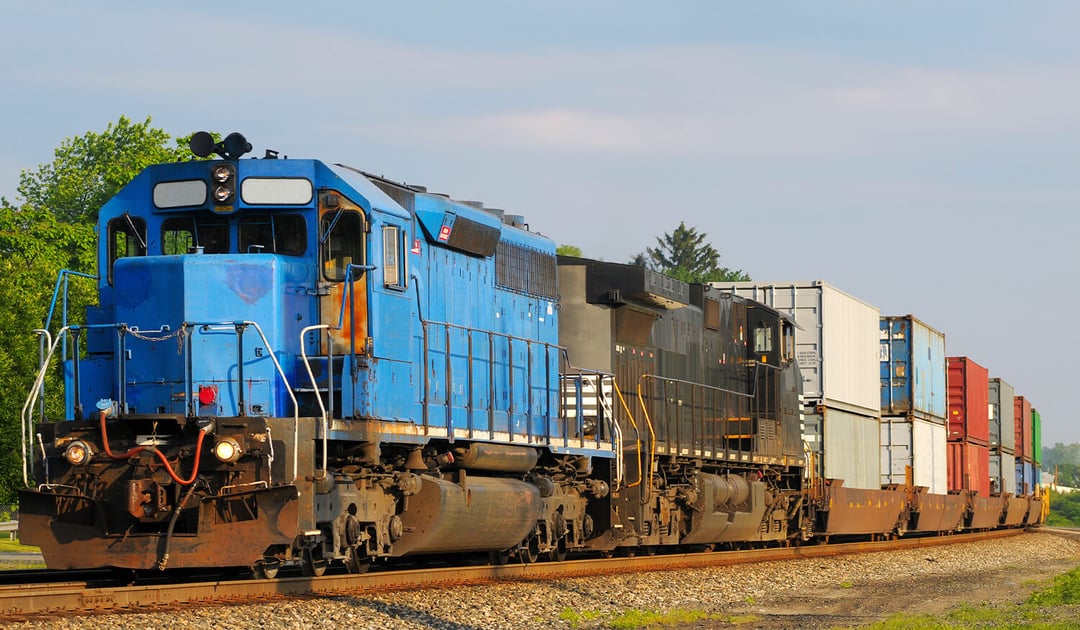Intermodal transportation at its basic level means shipment via two (or more) modes of transportation, and in everyday parlance, one of those is rail. So an intermodal example would involve a load of freight moving between truck and train, or ship and train, or ship and truck and train - or any combination of those shipping methods.
When it comes to the domestic intermodal, rail is best used to handle the bulk of the land-based journey. As far as what is in those containers, intermodal can move just about anything a truck can - what those in the industry like to call FAK (freight of all kinds). Let's get into a few more particular examples of intermodal.
Intermodal Example 1: The Overseas Shipment
Intermodal is a key transportation option at ports, with ocean containers sometimes moving straight from ship to train and other times cargo being transloaded into larger domestic containers for further transport. As roughly 69% of all U.S. traded goods are transported via the water at some point, this makes up a major chunk of intermodal freight - about 50% in fact are imports or exports.
Depending on the type of shipment, rail may take over directly from the port - think on-dock rail - whether transloading is involved or not. It often is though, as shippers can take advantage of the added capacity of domestic containers to essentially ship every 4th ocean container free. If a port doesn't have the right rail connection a shipper requires for a given route, drayage comes heavily into play.
Again, transloading plays a part in most cases. It can be done at a dedicated cross-docking or transloading facility, or a shipper's warehouse or distribution center. Regardless, dray trucks take the container(s) from the port either to that intermediate stop, or directly to another rail ramp if no transloading occurs. Then, in either a new domestic container or the original ocean container, they're loaded onto a train for the bulk of their journey.
Intermodal Example 2: Door-to-Door
Perhaps the greatest misconception about intermodal is that you must have a ramp right down the street to take advantage of this transportation mode. But the intermodal example that counters the myth is door-to-door. Door-to-door intermodal takes loads 100% of the journey from point A to point B, using a combination of dray trucks for the short haul portions at the beginning and end, and railroad for the long haul.
With more detail, this scenario begins at the manufacturing facility where the intermodal container - attached to an intermodal chassis - is loaded with products fresh off the line. A dray motor carrier picks it up, then drives it to the origin railroad ramp. Once the container arrives at the intermodal ramp, it is lifted off the chassis and placed onto a wellcar on a train.
The train then transports the intermodal container across the railroad network for the largest portion of the shipment, until it arrives at the rail ramp nearest the destination. Once the container makes it to that destination rail ramp, it is then lifted back off of the wellcar and transferred to another intermodal chassis. A dray truck then delivers the freight to its final destination.
As far as who makes the most sense for a door-to-door intermodal option, it does pay to be in reasonable distance of a rail ramp, but that reasonable distance can be as much as 300 miles away for the choice to make sense - though 100 or less is most ideal. In terms of the overall length of haul, 700 miles or more is a good benchmark to consider.
Intermodal Example 3: Cross-Border
While the term "domestic intermodal" may lead one to believe that the journey is within the U.S., it in fact covers all of North America. So if a shipper needs transport between Mexico and the U.S., the U.S. and Canada, or Mexico and Canada, domestic intermodal likely has it covered. In fact, there are a plethora of emerging options from the major Class I railroads, including both single line solutions and partnerships.
The advantages of cross-border intermodal are plentiful, with added security, smoother border crossings and lots of capacity for just about any product - including refrigerated and overweight items. These are on top of the general pluses to using intermodal, which include a reduced environmental footprint and often, significant cost savings.
Add the fact that Mexico is dealing with a truck driver shortage and labor issues, and the over-the-road border crossings are often backed up or even closed, there are many efficiencies to be gained from going intermodal cross-border. And virtually the entire U.S. can benefit following the criteria of distance from rail ramps.
Do your shipping needs match one of our intermodal transportation examples, or do you have another challenge for us to tackle? Just reach out to us and we'll be happy to work with you on your company on intermodal, or other solutions. For more information about InTek, or logistics and supply chain issues in general, check out our Freight Guides.



